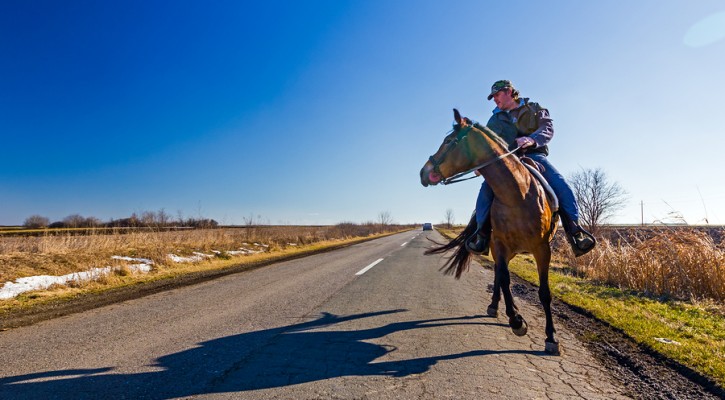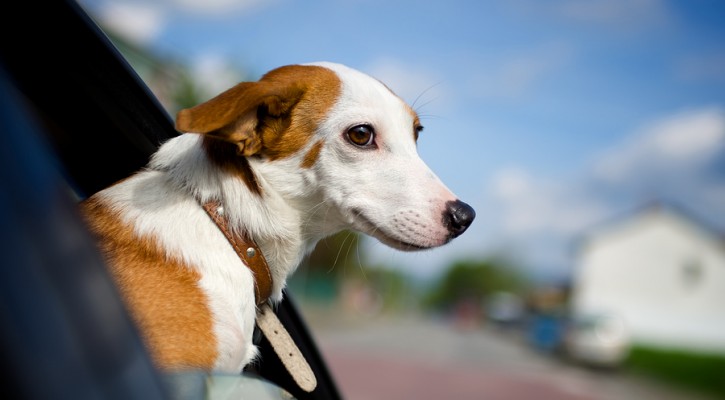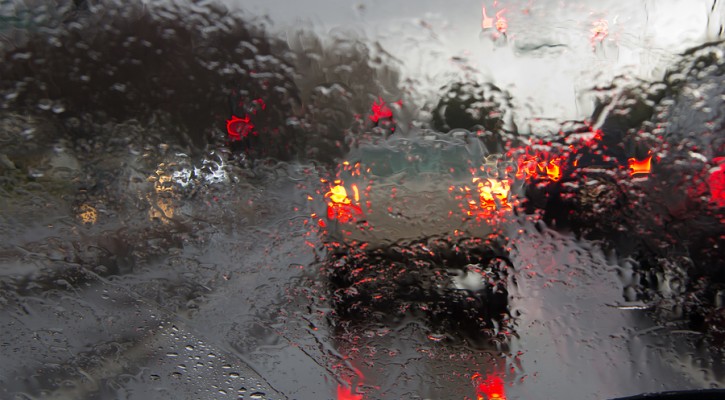Tag Archive: Safe driving

You Never Know
March 19, 2015
You never know what you may encounter on the roadway. Along with other traffic and pedestrians, drivers need to be aware of the possibility of horses and livestock on the road. A crash near Jacksonville Florida yesterday points out the necessity of watching for the unexpected while driving.
A man was riding a horse along a country road north of Jacksonville when they were hit by a car. The driver said she didn’t see them initially but, when she did, she hit the brakes but it was too late. The man was thrown from the horse and received critical injuries. The injured and frightened horse ran out into the roadway where it was hit and killed by another car.
In Florida, as well as most other states, horseback riders have a right to use the roadways. Horseback riders along with pedestrians, cyclists, motorcyclists, and those who use personal mobility devices are considered to be vulnerable road users. The Florida legislature is currently considering a bill to strengthen the penalties for anyone who injures or kills a vulnerable road user by careless or negligent actions.
Drivers on country roads may think they have a clear and unobstructed road but can be surprised by what may be around the next curve. Last year, while driving I was driving on a country road in North Georgia, other drivers approaching me flashed their lights at me. Thinking they were warning me of a patrol car ahead, I didn’t worry because I was traveling within the speed limit. What they were really trying to warm be about was a calf that had escaped its enclosure and was wandering alongside the road.
If you approach a horseback rider or a wandering cow from behind, keep in mind that the animal itself can only see straight ahead. The animal may be unaware of your presence. Slow down and give the animal a wide berth. Never honk your horn. That could cause the animal to panic and run out into the road.
You don’t necessarily have to be on a country road to encounter horseback riders. As part of the you never know what to expect file, take a look at this recent news report from Atlanta.
Read more: Car strikes and kills horse; Rider in critical condition

Can Courtesy Keep You Safe On The Road?
January 28, 2015
Courtesy is a hallmark of Japanese culture. It’s hard to think of Japan without the vision of hyper-polite citizens bowing to each other. One theory of Japanese etiquette is that it developed long ago to deal with the problems of a very large population living and working in a very small country. Along with courtesy, there’s also a strict adherence to society’s rules. This led me to wonder if Japanese courtesy and adherence to the rules extended to the roadways and how Japanese drivers compare with those in the US.
Japan is a tiny country. Japan’s 145,925 square miles – slightly smaller than Montana – make up less than four percent of the total land area in the US. In order to compare the two countries, we have to look at population density. The US with its wide open spaces has a population density of only 88.6 people per square mile. Japan’s population density, by contrast, is 873.1 people per square mile. That makes for very crowded conditions.
Out of all the nations in the world, the US has the greatest number of registered vehicles on the road. That may not come as a great surprise but the country with the second greatest number of registered vehicles is Japan. The US has 846.2 registered vehicles per 1,000 people followed by Japan with 650.9 vehicles per 1,000 people. Not only is Japan a crowded country, their roads are crowded too.
With that many vehicles in such a small space, you might think that Japan would have a high roadway death rate but that isn’t the case. When comparing the highway fatality rate of the two nations, the figures look like this:
|
Country |
Fatalities per 100,000 inhabitants |
Fatalities per 10,000 vehicles |
|
Japan |
4.1 |
0.6 |
|
US |
11.6 |
1.3 |
According to The International Transportation Forum, in 2012, the total highway fatality rate in each country was:
|
Country |
Total fatalities |
Percent change from 2011 |
|
Japan |
5,237* |
-4.9 |
|
US |
33,561 |
+3.3% |
*Out of all the highway deaths in Japan, 36% were pedestrians.
When you think of the US, you tend to think of a fast paced life style but Japan’s society is every bit as fast paced, if not more so.
When comparing speeding between the two countries:
- In the US in 2012 speeding was responsible for 30% of all fatalities with 10,219 lives lost in speed related crashes; an increase of two percent over 2011.
- In Japan, between 2002 and 2012, the number of crashes outside the motorway network involving speeds above 100 km/h (62 mph) decreased by 82%.
Could it be that the Japanese sense of courtesy and adherence to societal rules is responsible for the large difference in highway death rates? If Americans were just as courteous and law abiding on the roads, could we drastically reduce our highway death rates? There’s only one way to find out.

Ants Can Do It, Why Can’t We?
January 20, 2015
Ants, even when moving in large swarms seem to handle traffic, prevent traffic jams, and keep traffic flowing smoothly much better than humans can.
Physicist Apoorva Nagar at the Indian Institute of Space Science and Technology working on previous work by a group of German and Indian scientists has written a soon to be published paper on this phenomenon. The German and Indian scientist’s work showed that ants traveling in a line were able to move steadily and at a constant speed without bunching up. Nagar was able to show mathematically why large groups of ants seem to be able to move so steadily without causing a traffic jam.
According to Nagar, the reasons ants don’t jam up are:
- They don’t have egos; they don’t feel the need to pass everyone else.
- If there is a blockage, they don’t stop to rubberneck; they just keep moving steadily around the blockage.
- They seem to become more disciplined when the path narrows; they move in a straighter line and vary their speed less.
These are basic concepts in traffic flow management that many humans seem incapable of grasping. It’s hard to convince drivers that maintaining a longer following distance and traveling at a steady speed, even if that means going slower than the speed limit, will keep traffic moving smoothly and actually get them to their destination faster. It’s for this reason that advocates of self driving cars are hoping that, when the cars take over driving, traffic jams will be a thing of the past.
We have written on this issue before and have posted videos that explain why traffic jams occur and how to avoid them but they bear repeating.
Read more: Why Ants Handle Traffic Better Than You Do
Traffic Jam without bottleneck – experimental evidence
Traffic Waves

Ask The Traffic School Instructor: Pets In Cars
October 7, 2014
Question: Is it unsafe to drive with pets in cars?
Answer: It depends on how you transport the animal. Driving with unrestrained pets in a car can be dangerous for both you and the animal.
No matter how well trained an animal may be, they’re always unpredictable. It’s impossible to tell when something may be so enticing or frightening to an animal that it’s worth jumping out the window or clawing up the driver to escape. I’ll speak from a couple of my own experiences and hard learned lessons.
Many, many years ago we had a small terrier who used to accompany us when we ran errands or traveled. She had a lot of experience in the car and had never been a problem until one fateful day. We were traveling to a garden store that just happened to be across the street from her vet’s office. As soon as I turned the corner, even without looking out the window, she knew we were headed in the direction of the vet and she made a break for it by jumping out the open window into the middle of a very busy intersection. Fortunately, I was able to stop and other traffic cooperated by stopping long enough for me to catch her and get her safely back into the car.
On another occasion, we decided to get a kitten for our daughter. She had chosen a tiny kitten from a litter and we were on our way home on an interstate highway. So far, the sweet, tiny little kitten had remained very calm but, as I approached a toll booth, something spooked him. He raced right up my chest and dug his tiny, very sharp little claws into my face and held on for dear life. Luckily, there was very little traffic and I was already slowing for the toll booth. I had to steer with one hand and try to see around his body as I fought to rip his claws from my face. My three year old daughter thought it was hilarious.
If you’re the type of driver who likes to drive with pets in your lap, you might be heading for a big distraction if that pet wants to suddenly jump up and look out the window or try to escape. If a cat gets spooked in any way, you can count on being clawed as he tries to escape.
Even if the animal is calm and resting, if you have to suddenly hit the brakes, the animal is going to go flying into or under the dashboard; possibly interfering with your control of the gas and brake pedals. Depending on your speed at the time, it could lead to serious injuries for the animal.
Just like people, pets need to be restrained while in a car; either in a carrying case or by use of a halter designed to work with the seat belts. Now, when I travel out of state with my dog, she wears a travel harness and is clipped in to a D-ring in the cargo area behind the back seat. That’s the only way she has ever traveled. She’s used to it and remains very calm on our trips. It’s the best way to travel with a pet for both her safety and mine.

Ask The Traffic School Instructor: Emergency Flashers
October 1, 2014
Question: Should You use your emergency flashers when it is raining hard?
Answer: This is a common sight, especially in the South where heavy summer thunderstorms hit often. Driving with your emergency flashers on is not only illegal, it’s a really bad idea.
Emergency flashers are only supposed to be used on disabled vehicles to warn other drivers away. They can’t be used in the rain or to identify slow moving vehicles and there are good reasons for this.
Having personally witnessed multiple drivers using their flashers in heavy traffic during a rain storm, I can tell you it made it very confusing for me and, I’m sure, other drivers. The flashers made it hard to tell the difference between the vehicle’s emergency flashers and the brake lights. Determining when the brake lights came on was even more difficult because people tend to ignore the lights on a vehicle whose lights are continually flashing. It also makes it difficult to distinguish between a vehicle that is moving and one that may actually be disabled and stopped. With the lowered visibility due to the rain, the flashers just added to the hazards.
If it’s raining so hard that visibility is reduced to the point where you can’t see other traffic, drivers should pull off the road and wait until the storm passes. If you pull off the road and stop, then the emergency flashers can and should be used.
Using your emergency flashers to indicate that you are driving slower than other traffic is also illegal. Vehicles with mattresses tied to the roof with string or cars running on less than all cylinders don’t belong on the road. If you need to carry something that won’t fit inside your vehicle, you need to rent a trailer or a van. If your vehicle is unable, for whatever reason, to keep up with the flow of traffic, you should also stay off the road until the condition can be fixed.
